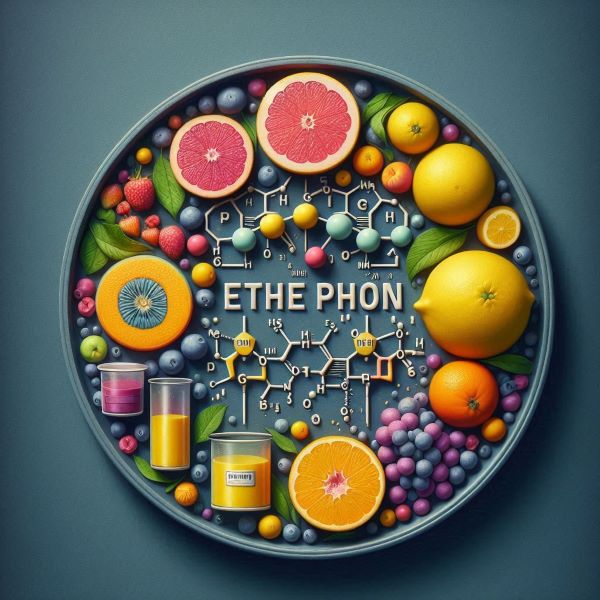In the agriculture industry, ensuring fruits ripen at the right time and appear attractive to consumers is crucial. Various methods are used to accelerate the ripening process, one of which involves the chemical ethephon. This article provides comprehensive information about ethephon, its usage, benefits, risks, regulatory status in India, and its status with the Food and Drug Administration (FDA).
What is Ethephon?
It (2-chloroethylphosphonic acid) is a plant growth regulator used extensively in agriculture. It is a colorless liquid that releases ethylene gas upon decomposition. Ethylene is a natural plant hormone that regulates various physiological processes, including fruit ripening. Ethephon is absorbed by the plant tissues, where it breaks down and releases ethylene, thereby promoting ripening. (Source)
Also, read: All You Need to Know About Acetylene Gas, a Chemical Used to Ripen Fruits
Description and Usage
It is widely used in the fruit industry to control and accelerate the ripening process. It ensures that fruits ripen uniformly and are market-ready when they reach consumers. This method is particularly useful for fruits that are picked unripe and transported over long distances. (Source)
How Ethephon is Used:
- Spraying: It can be sprayed directly onto fruits while they are still on the tree or after they have been harvested. This method is commonly used for apples, tomatoes, and pineapples.
- Dipping: Fruits can be dipped in an ethephon solution to induce ripening.
- Injection: In some cases, ethephon is injected into the plant or fruit to ensure even distribution.
Benefits of Using Ethephon
- Efficiency: It provides a controlled and predictable ripening process.
- Uniform Ripening: It ensures fruits ripen uniformly, improving their marketability.
- Reduced Waste: By controlling the ripening process, ethephon helps reduce the loss of fruits due to overripening during transportation. (Source)
Risks and Health Concerns
While it is effective in promoting fruit ripening, there are certain risks and health concerns associated with its use:
- Health Risks: Residues of it on fruits can pose health risks if not properly managed. Consumption of high levels of ethephon can lead to:
- Gastrointestinal issues such as nausea and vomiting
- Respiratory problems due to inhalation of fumes during application
- Skin and eye irritation upon contact
- Environmental Risks: Ethephon can contaminate soil and water if not used properly, affecting plant and animal life.
- Workplace Safety: Workers handling ethephon need proper training and protective equipment to avoid exposure. Inadequate safety measures can result in health hazards.
Also, watch web stories: What are the Health Benefits of Brisk Walking?
Which States and Fruits Use Maximum Ethephon?
In India, the use of it is prevalent in states with high fruit production. States like Maharashtra, Tamil Nadu, and Karnataka, known for their extensive cultivation of fruits, frequently use ethephon for ripening.
Fruits Commonly Ripened with Ethephon:
- Apples: Widely ripened using it to ensure they reach the market in optimal condition.
- Tomatoes: Often treated with this to control the ripening process and improve shelf life.
- Pineapples: It is used to promote uniform ripening and enhance the fruit’s color and flavor.
Is Ethephon Banned in India?
No, the use of it for ripening fruits is not banned in India. The Food Safety and Standards Authority of India (FSSAI) allows the use of it as a ripening agent, provided it is used in compliance with prescribed guidelines. The FSSAI has set maximum residue limits (MRLs) for ethephon on fruits to ensure consumer safety.
FDA Status
The Food and Drug Administration (FDA) in the United States has approved this for use in agriculture under specific conditions. It is registered for use on various crops, including fruits and vegetables. The FDA and the Environmental Protection Agency (EPA) have established MRLs for ethephon residues on food products to protect consumer health.
Safer Alternatives and Best Practices
While it is considered safe when used correctly, adopting best practices is crucial to minimize risks:
- Proper Application: Follow recommended guidelines for the application of ethephon to ensure safe and effective use.
- Training: Ensure workers handling ethephon are trained in its safe use and understand the importance of protective equipment.
- Monitoring: Regularly monitor residue levels on fruits to ensure they comply with safety standards.
Conclusion
It is a widely used and effective chemical for ripening fruits, offering numerous benefits in terms of efficiency and uniformity. While it is approved for use in India and by the FDA, it is essential to follow safety guidelines and best practices to minimize health and environmental risks. Consumers can enjoy fresh, ripe fruits knowing that when used correctly, ethephon poses minimal risks.





